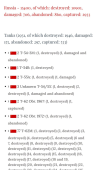Antares
Respected Leader
Mielenkiintoinen laskelma, jossa pyritään arvioimaan, mikä määrä panssarivaunuja ryssällä voisi olla Ukrainassa:
In the attached thread I tried to calculate how many tanks Russia currently has on the front, and therefore how much armor potential they have lost since the beginning of the war.
LINKKI
I recently estimated that Russia has about 1,700 tanks on the front line. However, for the last month I have been reviewing the weapons of individual groups of Russian armies and it turned out that 1,700 pieces is a significantly lower number.
This is probably related to the overstatement of Russian losses in GSUA reports. Therefore, the algorithm I used to calculate the arithmetic average of GSUA data and Oryx visual confirmations is not appropriate.
So let's try to calculate the number of tanks lost by the Russians since February 24, 2022.
From my observations this year, the most reliable loss numbers are also given by visual confirmer @AndrewPerpetua , and they are higher than the data given by Oryx by about 50%.
Unfortunately, Andrew has not kept his statistics since the beginning of the conflict, so let's calculate the number of Russian tank losses by overestimating the last update of Oryx - 2,931 pieces by 50%, i.e. Russian tank losses will be approximately 4,400 pieces

Before the conflict in Ukraine began, the Russian army had, depending on the sources, from 2,700 to 4,000 tanks, let's assume the higher number.
According to Minister Shoigu's annual reports to the State Duma, in 2022 Russia produced and overhauled about 800 units, while in 2023 the production was almost symbolic, and Russia relied almost exclusively on overhauls, thanks to which it introduced 1,500 units into the line.
From January, Russia planned to increase modernization up to 200 pieces per month, so let's assume from January 1 to mid-April the number is 700 pieces.
That is, if there were no losses, Russia should have about 7,000 tanks on the front.
LINKKI
By subtracting the number 4,400 from the number 7,000, we get that Russia should currently have about 2,600 tanks on the front, which means that it has lost about 63% of the armored potential it should have had if it had not conducted military operations.
Now check how many tanks there are in individual Russian Army Groups, according to data provided by Ukrainian military experts Alexander Kovalenko and Konstantin Mashowiec, in order:
Army Group "Dnieper" - about 600 pieces,
Army Group "Vostok" - about 350 pieces,
Army Group "Center" - about 350 pieces,
Army Group "South" - about 500 pieces,
Army Group "Zapad" - about 1,000 pieces,
in total approximately 2,800 pieces.
Probably the actual number of Russian tanks on the front is between 2,600 and 2,800 pcs.
-
Kommenteista yksi poiminta: Id optimistically guess, based on your numbers, logistic and time constraints, that the number of operational pieces is likely around 2000. That is probably still double of what Ukraine has, perhaps in total.
Johon MądryKot316 vastasi näin: Exactly, that's why Ukraine went on the defensive, to eliminate as much Russian equipment as possible, even at the expense of lost territories.
-
Muistan nähneeni hieman vastaavia arvioita aikaisemminkin eli "ryssä olisi kyennyt säilyttämään suorituskykynsä" - mikä tarkoittaisi suorituskykyä pelkillä panssarivaunujen numeromäärällä laskien.
Minun arvioni mukaan Venäjän aktiivijoukoilla oli 2 700 panssarivaunua ennen Ukrainaan hyökkäämistä, tosin jos kykenivät muodostamaan uusia panssarivaunupataljoonia ennen hyökkäystä, silloin määrä voisi olla hieman suurempi (tuskin kuitenkaan yli 3 000). Toki erilaisissa panssarisotakouluissa on väitetysti "muutama sata" panssarivaunua, joten kenties käytettävissä olevien panssarivaunujen määrä oli kaikkinensa tuollainen 3 000 kpl. Näiden lisäksi sitten varastotukikohdat, armored repair plant yms. missä oli sekalainen määrä panssarivaunuja kunnostettavana ja modernisoitavana.
Se mitä yritän sanoa: mielestäni 3 000 on kohtuullisen hyvä arvaus laskelman lähtökohdaksi mutta 4 000 on aivan liian suuri.
Toisaalta, tämä tarkoittaisi hänen laskelmassaan miinus 1 000 kpl ja silloin lopputulos olisi 1 600 kpl panssarivaunuja Ukrainassa tällä hetkellä - mikä on useamman arvion mukaan liian vähän, selvästi liian vähän. Voidaan tietysti kyseenalaistaa näiden arvioiden todenperäisyys, mutta yhtä hyvin arviot sodan aikana valmistettujen, modernisoituja ja varastoista aktivoitujen panssarivaunujen määrästä voivat olla väärin, samoin menetettyjen vaunujen määrä.
-
MUOKKAUS: hänellä on myös samanlainen laskelma AFV + IFV + APC vaunujen määrälle:
In the attached thread I tried to calculate how many tanks Russia currently has on the front, and therefore how much armor potential they have lost since the beginning of the war.
LINKKI
I recently estimated that Russia has about 1,700 tanks on the front line. However, for the last month I have been reviewing the weapons of individual groups of Russian armies and it turned out that 1,700 pieces is a significantly lower number.
This is probably related to the overstatement of Russian losses in GSUA reports. Therefore, the algorithm I used to calculate the arithmetic average of GSUA data and Oryx visual confirmations is not appropriate.
So let's try to calculate the number of tanks lost by the Russians since February 24, 2022.
From my observations this year, the most reliable loss numbers are also given by visual confirmer @AndrewPerpetua , and they are higher than the data given by Oryx by about 50%.
Unfortunately, Andrew has not kept his statistics since the beginning of the conflict, so let's calculate the number of Russian tank losses by overestimating the last update of Oryx - 2,931 pieces by 50%, i.e. Russian tank losses will be approximately 4,400 pieces

Before the conflict in Ukraine began, the Russian army had, depending on the sources, from 2,700 to 4,000 tanks, let's assume the higher number.
According to Minister Shoigu's annual reports to the State Duma, in 2022 Russia produced and overhauled about 800 units, while in 2023 the production was almost symbolic, and Russia relied almost exclusively on overhauls, thanks to which it introduced 1,500 units into the line.
From January, Russia planned to increase modernization up to 200 pieces per month, so let's assume from January 1 to mid-April the number is 700 pieces.
That is, if there were no losses, Russia should have about 7,000 tanks on the front.
LINKKI
By subtracting the number 4,400 from the number 7,000, we get that Russia should currently have about 2,600 tanks on the front, which means that it has lost about 63% of the armored potential it should have had if it had not conducted military operations.
Now check how many tanks there are in individual Russian Army Groups, according to data provided by Ukrainian military experts Alexander Kovalenko and Konstantin Mashowiec, in order:
Army Group "Dnieper" - about 600 pieces,
Army Group "Vostok" - about 350 pieces,
Army Group "Center" - about 350 pieces,
Army Group "South" - about 500 pieces,
Army Group "Zapad" - about 1,000 pieces,
in total approximately 2,800 pieces.
Probably the actual number of Russian tanks on the front is between 2,600 and 2,800 pcs.
-
Kommenteista yksi poiminta: Id optimistically guess, based on your numbers, logistic and time constraints, that the number of operational pieces is likely around 2000. That is probably still double of what Ukraine has, perhaps in total.
Johon MądryKot316 vastasi näin: Exactly, that's why Ukraine went on the defensive, to eliminate as much Russian equipment as possible, even at the expense of lost territories.
-
Muistan nähneeni hieman vastaavia arvioita aikaisemminkin eli "ryssä olisi kyennyt säilyttämään suorituskykynsä" - mikä tarkoittaisi suorituskykyä pelkillä panssarivaunujen numeromäärällä laskien.
Minun arvioni mukaan Venäjän aktiivijoukoilla oli 2 700 panssarivaunua ennen Ukrainaan hyökkäämistä, tosin jos kykenivät muodostamaan uusia panssarivaunupataljoonia ennen hyökkäystä, silloin määrä voisi olla hieman suurempi (tuskin kuitenkaan yli 3 000). Toki erilaisissa panssarisotakouluissa on väitetysti "muutama sata" panssarivaunua, joten kenties käytettävissä olevien panssarivaunujen määrä oli kaikkinensa tuollainen 3 000 kpl. Näiden lisäksi sitten varastotukikohdat, armored repair plant yms. missä oli sekalainen määrä panssarivaunuja kunnostettavana ja modernisoitavana.
Se mitä yritän sanoa: mielestäni 3 000 on kohtuullisen hyvä arvaus laskelman lähtökohdaksi mutta 4 000 on aivan liian suuri.
Toisaalta, tämä tarkoittaisi hänen laskelmassaan miinus 1 000 kpl ja silloin lopputulos olisi 1 600 kpl panssarivaunuja Ukrainassa tällä hetkellä - mikä on useamman arvion mukaan liian vähän, selvästi liian vähän. Voidaan tietysti kyseenalaistaa näiden arvioiden todenperäisyys, mutta yhtä hyvin arviot sodan aikana valmistettujen, modernisoituja ja varastoista aktivoitujen panssarivaunujen määrästä voivat olla väärin, samoin menetettyjen vaunujen määrä.
-
MUOKKAUS: hänellä on myös samanlainen laskelma AFV + IFV + APC vaunujen määrälle:
Viimeksi muokattu:







